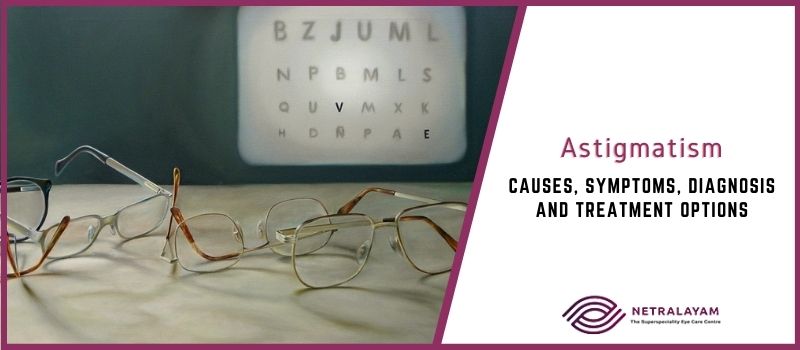Committed to Eye Care with Compassion, Technology and Competency
Committed to Eye Care with Compassion, Technology and Competency

8/25/2021
Astigmatism is a common vision problem caused by an error in the cornea shape, i.e., the front surface of the eye that leads to blurred long-distance and near vision. In this condition, your eye lens or the cornea has an asymmetrical curve and resembles an oval rugby ball, or an egg, making your vision blurry. Astigmatism is often present as a congenital defect and can occur along with nearsightedness or farsightedness. Generally, astigmatism can be corrected through eyeglasses or refractive surgery. However, it may not always be pronounced enough to need corrective glasses or surgery.
It is caused by an asymmetrical curvature of the cornea or lens of the eye. Due to this condition, the light rays aren’t refracted properly, and this causes distorted vision at near and far distances. Astigmatism can occur in children and adults. The risk of developing astigmatism can be higher if you have:
An eye exam diagnoses astigmatism. The doctor will conduct a thorough eye examination that will involve a series of tests to check the eyes' health and refraction that will determine how the eye bends the light. The doctor may use various instruments like a keratometer or a keratoscope machine that shines a light at the eye and measures the distortion of the light reflected by the cornea. He will then ask you several questions about the health of your eyes. The doctor will then use these tests to examine various aspects of the eyes and determine the prescription needed to provide a clear vision with the help of eyeglasses or contact lenses.
Astigmatism signs and symptoms are linked to distorted vision and can include blurry vision and eye strain. It makes it difficult for an individual to see fine details up close or at a distance. The symptoms associated with astigmatism are as follows:
Mild astigmatism might not require any treatment unless you conduct activities like staring at a computer screen for prolonged hours that can worsen the condition. In other cases, the doctor may use the following tests to diagnose astigmatism and figure out how severe it is:
Refraction: The doctor will make you look through a phoropter machine to analyze which lens choice helps you see clearly. This will help them figure out your prescription to help correct astigmatism.
Otherwise, your doctor will check your eyes through a handheld device called a retinoscope.
Vision test: The doctor will make you read letters on a standard eye chart from 20 feet away. If your vision is 20/20, you can see from 20 feet away what a normal eye can see, and if your eyesight is 20/80, you must be 20 feet away to see what a normal eye can see from 80 feet away.
Keratometer: This machine measures the curvature of the cornea, enabling the doctor to know the shape of the cornea and how well it can focus.
Corneal topography: This advanced technology provides the most detailed information about the cornea’s shape. The device can collect thousands of tiny measurements.
Astigmatism can be corrected by the following treatment methods:
Corrective lenses counteract the even curvatures of the cornea and lens and can mitigate the sight condition. There are two types of lenses for astigmatism correction:
Eyeglasses: Eyeglasses are made with lenses that can bend the light into your eye properly, compensating for the uneven shape of your eye.
Contact lenses: Contact lenses function like eyeglasses and can correct most astigmatism errors. They are available in disposable soft, permeable, extended-wear, gas, rigid, and bifocal varieties.
Your doctor can help you decide the type of corrective lenses suitable for you.
Refractive surgery enhances vision and minimizes the need to wear eyeglasses or contact lenses. During this surgery, your eye surgeon uses a laser beam to restructure your cornea curves to correct the refractive error. However, before the surgery, your doctor will evaluate you to check if you are a suitable candidate for the surgery and the type of surgery you require.
Types of refractive surgery to correct astigmatism:If you are suffering from the symptoms of astigmatism, book an appointment with our medical team at Netralayam, the Superspeciality Eye Care Centre, in Kolkata for the best medical services and treatment for astigmatism. Our doctors can evaluate you to determine the best treatment option for you.
Comments are closed
